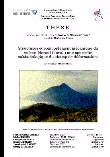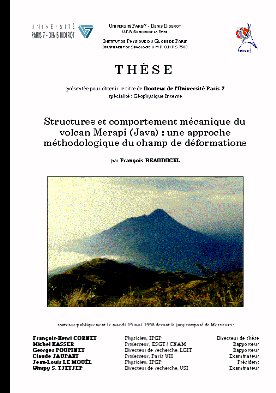 |
Structures and mechanical behaviour of Merapi Volcano, Java: a methodological approach of the deformation field
François Beauducel
Doctorate Thesis, Univ. Paris VII, Institut de Physique du Globe de Paris, pp. 260, 1998. Attended ones viva on May 19, 1998.
|
Jury members: Jean-Louis Le Mouël (IPGP), president; Georges Poupinet (LGIT) & Michel Kasser (ESGT), reviewers; Claude Jaupart (Paris 7) & Wimpy S. Tjetjep (VSI), examinators; François H. Cornet (IPGP), advisor.
Abstract.
Surface deformation studies allow investigation of deep and shallow structures of volcanic edifices (reservoir, conduit, fractures). The geometry of this hidden « plumbing system » constitutes one of the boundary conditions of magmatic phenomena, and are essential parameters for understanding volcanic eruptions. In this work we apply a methodology from measurement to modelling of the deformation field on Merapi Volcano, Java. This young island arc strato-volcano (summit ~2964 m above sea-level) shows almost continuous activity with growth of an andesitic lava dome, which collapses in glowing avalanches, explosions and nuées ardentes, these are sometimes deadly. Five GPS (Global Positionning System) campaigns were carried out between 1993 and 1997 on a 14-point network. Four continuous multi-parameter stations (tiltmeters, extensometers) were installed between 1993 and 1995, on the summit and the flank of the volcano. Signals are corrected for meteorological effects, then combined to reduce the uncertainties. Comparison of the results allows an analysis of the mechanical behaviour of the instrumented sites. The data are interpreted using a 3D elastic model based on the Mixed Boundary Elements Method (MBEM). Topography and the main discontinuities of the edifice are taken into account. The data are then used in an inversion process which allows the model probability and uncertainties of the computed parameters to be estimated. The far-field deformation (1996 - 1997) is modelled with an horizontal elliptic magma source for which we determine the location (8.5 ± 0.4 km below the summit) and the volume change (-10.8 ± 2.2 × 106 m3). This value is about three times larger than the observed variation of the lava dome volume. This suggests that avalanche volume cannot be neglected when considering mass balance. The near-field deformation (1993 to 1997) is modelled assuming a magma conduit under pressure and viscous wall shear stresses. We analyse the effect of fractures on the displacement field and finally, three main fractures are included a priori in the medium. The pressure evolution in the conduit suggests that the lava dome weight has a negligible effect on deformations. The variations of wall shear stress are consistent with the number of « multiphase » seismic events ; this gives further evidence for the origin of these events.
 |
Struktur dan mekanika Gunung Merapi (Jawa) : suatu pendekatan metodologis medan deformasi
François Beauducel
Tesis Doktorat (S3), Univ. Paris VII, Institut de Physique du Globe de Paris, pp. 260, 1998. Diujikan pada tanggal 19 Mei 1998.
|
Diujikan di depan juri yang terdiri dari Pr. Dr.: J.L. Le Mouël (IPGP), presiden; G. Poupinet (LGIT) & M. Kasser (ESGT), pemeriksa; C. Jaupart (Paris 7) & W.S. Tjetjep (VSI), penguji; dan F.H. Cornet (IPGP), pembimbing.
Abstrak.
Studi deformasi bertujuan untuk mengetahui struktur dalam dan dangkal tubuh gunungapi (kantong magma, pipa kepundan dan struktur rekahan). Bentuk geometri dari struktur yang tidak diketahui tersebut adalah suatu faktor utama yang berperan dari setiap fenomena magmatik, sebagai parameter yang penting untuk memahami aktifitas letusan. Dalam tesis ini, kami menerapkan sebuah metodologi mulai dari pengukuran sampai dengan modelisasi medan deformasi di gunung Merapi (Jawa). Gunung api busur kepulauan jenis strato ini (2964 m) memperlihatkan aktifitas yang menerus yang dicirikan oleh pertumbuhan kubah lava andesitik, penghancuran kubah melalui guguran lava pijar, letusan dan awan panas (nuées ardentes) yang dapat menimbulkan korban jiwa. Lima kali pengukuran GPS (Global Positioning System) telah dilakukan mulai tahun 1993 sampai tahun 1997 pada 14 jaringan titik pengukuran. Empat stasiun rekaman kontinyu multy parameter (tiltmeter, ekstensometer) juga dipasang antara tahun 1993 dan 1995 di puncak dan di lereng tubuh gunungapi. Sinyal dikoreksi terhadap pengaruh cuaca untuk mendapatkan data yang berlaku dan mengurangi kesalahan interpretasi. Perbandingan dari perbedaan hasil yang didapatkan memungkinkan kami untuk menganalisa pengaruh mekanik dari lokasi peralatan terpasang. Interpretasi data mempergunakan model elastik 3D dengan metoda MBEM (Mixed Boundary Elements Method) yang memperhitungkan topografi dan diskontinyu tubuh gunungapi. Data dimasukkan melalui proses inversi yang dapat mengestimasi kemungkinan model dan ketidakpastian parameter-parameter yang dihitung. Medan deformasi jauh (1996 - 1997) dimodelisasikan berdasarkan model magma elipsoida horisontal yang berada pada 8.5 ± 0.4 km dibawah puncak dan variasi volume -10.8 ± 2.2 106 m3. Nilai ini kurang lebih 3 kali lebih besar dari volume kubah lava yang teramati. Hal ini menunjukkan bahwa volume guguran tidak dapat diabaikan dalam perhitungan massa. Medan deformasi dekat (1993 s/d 1997) dimodelisasikan berdasarkan sebuah pipa magma yang tertekan dengan stres geser dan tiga rekahan utama dalam tubuh gunung, kemudian kami menganalisa implikasi pada pergerakan medan. Evolusi tekanan pada pipa kepundan mengilhami bahwa berat kubah lava mempunyai efek yang dapat diabaikan.Variasi stres geser sangat sesuai dengan jumlah getaran fase banyak (multiphases seismic events) ; hal ini mengkonfirmasikan sumber dari kejadian-kejadian tersebut.
Terima kasih atas Bapak Wimpy S. Tjetjep yang membetulkan terjemakan ini.
 |
Structures et comportement mécanique du volcan Merapi (Java) : une approche méthodologique du champ de déformations
François Beauducel
Thèse de Doctorat, Univ. Paris VII, Institut de Physique du Globe de Paris, pp. 260, 1998. Soutenue le 19 Mai 1998.
|
Jury: J.L. Le Mouël (IPGP), président; G. Poupinet (LGIT) & M. Kasser (ESGT), rapporteurs; C. Jaupart (Paris 7) & W.S. Tjetjep (VSI), examinateurs; F.H. Cornet (IPGP), directeur.
Résumé.
L'étude des déformations nous renseigne sur les structures profondes et superficielles des volcans (réservoir, conduit, fracture). La géométrie de cette « plomberie » cachée constitue l'une des conditions aux frontières de tous les phénomènes magmatiques, paramètres indispensables à la compréhension des éruptions. Dans ce travail, nous appliquons une méthodologie allant de la mesure à la modélisation du champ de déformations sur le Merapi (Java). Ce jeune strato-volcan d'arc insulaire (2964 m) présente une activité quasi continue avec production de dômes de lave andésitique, détruits par avalanches gravitaires, explosions et nuées ardentes parfois meurtrières. Cinq campagnes GPS (Global Positionning System) ont été effectuées de 1993 à 1997 sur un réseau de 14 points. Quatre stations continues multi-paramètres (inclinomètres, extensomètres) ont été installées entre 1993 et 1995 au sommet et sur le flanc de l'édifice. Les signaux sont corrigés des effets météorologiques, puis validés par compensation pour réduire les incertitudes. La comparaison des différents résultats nous permet une analyse des effets mécaniques des sites instrumentés. Pour modéliser nos observations, nous utilisons le code MBEM (Mixed Boundary Elements Method) qui prend en compte la topographie et les principales discontinuités de l'édifice dans un milieu élastique 3D. Les données sont introduites dans un processus d'inversion qui permet d'estimer la probabilité du modèle et l'incertitude sur les paramètres calculés. Le champ de déformation lointain (1996 à 1997) est modélisé par une chambre magmatique ellipsoïdale dont nous déterminons la position (8.5 ± 0.4 km sous le sommet) et la variation de volume (-10.8 ± 2.2 106 m3). Cette valeur correspond à environ 3 fois celle du dôme au sommet, ce qui montre que les avalanches gravitaires ne peuvent être négligées dans un bilan de masse. Le champ de déformation proche (1993 à 1997) est modélisé par un conduit magmatique soumis à des contraintes de pression et de cisaillement axial, et la présence de 3 fractures dans l'encaissant. L'évolution de la pression semble suggérer que le poids du dôme de lave a un effet négligeable sur les déformations. Les variations de cisaillement sont parfaitement compatibles avec le nombre de séismes de type « multiphases », ce qui confirme l'origine de ces événements.
 |
Ma thèse est disponible sous forme d'un seul fichier Adobe Acrobat PDF. Ce fichier permet de visualiser et/ou d'imprimer le document complet, textes et figures (couverture et pages de garde incluses), exactement tel qu'il a été édité sur papier à l'Université Paris 7 (260 pages).
Pour un avant-goût en HTML, lisez la description de mon Doctorat IPGP, le résumé, et en totalité: l'avant-propos, les remerciements, la table des matières et l'introduction générale.
Charger le document complet: 
| Si vous n'avez pas encore le logiciel gratuit Foxit Reader: |
 |
|



